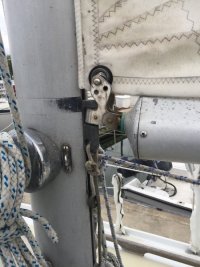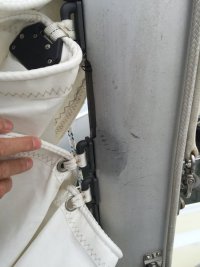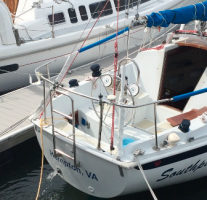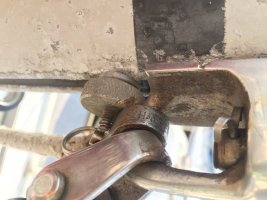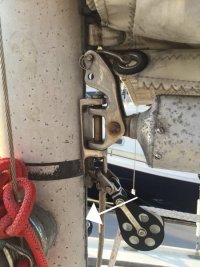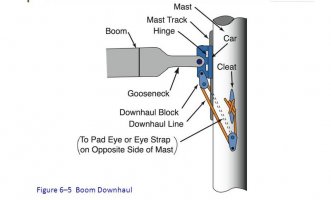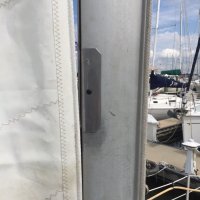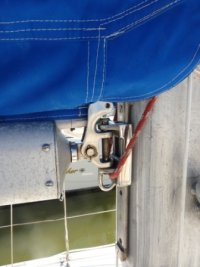You are using an out of date browser. It may not display this or other websites correctly.
You should upgrade or use an alternative browser.
You should upgrade or use an alternative browser.
E27 mainsheet set up
- Thread starter JPS27
- Start date
BTW Mark. Thanks again for meeting with me about lowering the mast. I haven't moved on it yet. Wind has just come back to the delta and the weather is warming. Hope to have you up for a sail soon. Weekends work for you? I always look for an excuse to take a weekday off!
prioritizing changes to mainsheet/boom issues
All your advice as been great learning experience. It's amazing what you don't see when you don't know any better. Definitely keeping life interesting and challenging. So I moved my boom up to the black line that I never noticed before. It was about 5-6 inches up. The stop Grant mentioned was right there where it was supposed to be, just low. The sail had room to move up at the masthead, but I'm taking my field glasses to get a better look today.
I thought a priority list would be: 1) i'm going to put back the old mainsheet config and if possible with the additional room now btw the boom and traveler use three bail points, not two. 2) I am frustrated with the fact that my slugs cannot move up the track without someone at the mast guiding them past the gap. Seems the small pin could never hold their weight if I let all slugs sit above that gap, and my sail cover would cease to fit. What would you do? I was thinking a sail track, which would make a much happier first mate. 3) down the road look at moving mainsheet back to original end of boom position.
However, point three would require taking off the pedestal guard (right term?). if you can see in the pic of the cockpit a PO (there were three) cut out two spots in the mainsheet track to accommodate guard. I would need to take out the guard and put in a new track. I have not studied these systems so don't know what that entails and costs.
Questions are implied so feel free to give advice. Thanks as always. This site is a godsend. Jay



All your advice as been great learning experience. It's amazing what you don't see when you don't know any better. Definitely keeping life interesting and challenging. So I moved my boom up to the black line that I never noticed before. It was about 5-6 inches up. The stop Grant mentioned was right there where it was supposed to be, just low. The sail had room to move up at the masthead, but I'm taking my field glasses to get a better look today.
I thought a priority list would be: 1) i'm going to put back the old mainsheet config and if possible with the additional room now btw the boom and traveler use three bail points, not two. 2) I am frustrated with the fact that my slugs cannot move up the track without someone at the mast guiding them past the gap. Seems the small pin could never hold their weight if I let all slugs sit above that gap, and my sail cover would cease to fit. What would you do? I was thinking a sail track, which would make a much happier first mate. 3) down the road look at moving mainsheet back to original end of boom position.
However, point three would require taking off the pedestal guard (right term?). if you can see in the pic of the cockpit a PO (there were three) cut out two spots in the mainsheet track to accommodate guard. I would need to take out the guard and put in a new track. I have not studied these systems so don't know what that entails and costs.
Questions are implied so feel free to give advice. Thanks as always. This site is a godsend. Jay
Attachments
Confirm that putting a stop to keep the sail slugs above the slot really does overstack the sail cover.
If so, then just recreate the missing "gate" for the slug-entry slot. It's just a little plate of aluminum, held in place by a screw or two, that lets the slugs run past but keeps them from falling out on the way down. You could use plastic or oak or titanium--doesn't matter, no force on it anyhow. Duct tape something on and see.
Of course, if you are considering a Tides Sailtrack, they have many fans and absolutely solve the sticking slugs common on older boats. In that case you will grind an even larger opening in the luff track, slip in the Tides track, install the Tides gate, put new high-class slugs on the sail, and achieve, as I have, the smug sense of entitlement that only money can buy.
I'd sail with the mid-boom setup for a while and see what you think. Undoing the mod gets complicated and expensive and will leave holes in your cabin house.
If so, then just recreate the missing "gate" for the slug-entry slot. It's just a little plate of aluminum, held in place by a screw or two, that lets the slugs run past but keeps them from falling out on the way down. You could use plastic or oak or titanium--doesn't matter, no force on it anyhow. Duct tape something on and see.
Of course, if you are considering a Tides Sailtrack, they have many fans and absolutely solve the sticking slugs common on older boats. In that case you will grind an even larger opening in the luff track, slip in the Tides track, install the Tides gate, put new high-class slugs on the sail, and achieve, as I have, the smug sense of entitlement that only money can buy.
I'd sail with the mid-boom setup for a while and see what you think. Undoing the mod gets complicated and expensive and will leave holes in your cabin house.
Last edited:
lonokai
Member III
Boom position
After reading this thread and looking at CW's illustration, I wonder if my boom is positioned too high. (See attached photo). Sometimes, there's a "click" as though the boom is coming out of the track on the mast. A friend suggested moving it down a couple of inches (see arrow in photo).

After reading this thread and looking at CW's illustration, I wonder if my boom is positioned too high. (See attached photo). Sometimes, there's a "click" as though the boom is coming out of the track on the mast. A friend suggested moving it down a couple of inches (see arrow in photo).
Attachments
Reposition gooseneck so the tack of the sail is at the black line.
Also, replace the distorted cotter ring-they are guaranteed to grab lines. A cotter pin is preferred.
Also, replace the distorted cotter ring-they are guaranteed to grab lines. A cotter pin is preferred.
lonokai,
Remember that your sail still has to fit!
If you raise it too high, you won't have enough halyard to adjust tension on the main. The black line should be in-line with the boom (one-design rule). However the cut of the main really drives what you need (who races one-design E27's anyways?). A little above or below will not matter that much.
Remember that your sail still has to fit!
If you raise it too high, you won't have enough halyard to adjust tension on the main. The black line should be in-line with the boom (one-design rule). However the cut of the main really drives what you need (who races one-design E27's anyways?). A little above or below will not matter that much.
Thanks for that....also, how do we prevent the gooseneck from traveling upwards during sailing...?
Sometimes it helps a bit to know the history. Traditionally there were sliding goosenecks. The sailmaker would build a sail that fit where a (presumably) knowledgeable owner would tell him to do so. Racing called for precise measurement of the sides of the Main sail, and when a few owners would put on larger sails than their measurement certificate showed they could gain some sail area... until they might be protested and forced to become honest for a while. Soon the sail boat boom in the 70's produced enough same-model boats from major builder to be able to specify a "standard" mail sail size for each model and factory rig size.
To make it easy for competitors to see if the boats around them were "legal" they could look for the 'black band' denoting the maximum length for each side of the main.
At that point, the gooseneck changed and with no need to have it move anyway it became fixed in place. The mast bracket on ours has about 4 or 5 large screws tapped into the mast on each side of the slot, for instance. Some builders made this change sooner than others, and it did simplify spar building to some extent. Sailmakers were happy, too.
It's not usual for boats built in the 60's and 70's to their original gooseneck pinned in place "permanently" or just replaced for additional $.
One bit of sail control rigging that emerged from all this was the Cunningham Cringle for tensioning the lower part of the luff.
I would guess that for simplicity and thrift most owners of 70's boats just drill and tap a 1/4" screw into the mast, through the gooseneck and lock it at the position that puts the faded black band at the top of the boom...
My .02 worth, and YMMV.
Loren
How do we prevent the gooseneck from traveling upwards during sailing...?
(in your picture) That line attached to the bottom ring of the gooseneck via eye splice... it should be secured to a cleat directly below which is also mounted in the sail track.
For our vintage boat...(I believe) originally no sail stop was used to hold up the boom. The boom was supported by raising the main. Then, the boom adjusted downward for the correct halyard tension. At least that is what a old timer told me. Makes sense.
(in your picture) That line attached to the bottom ring of the gooseneck via eye splice... it should be secured to a cleat directly below which is also mounted in the sail track.
For our vintage boat...(I believe) originally no sail stop was used to hold up the boom. The boom was supported by raising the main. Then, the boom adjusted downward for the correct halyard tension. At least that is what a old timer told me. Makes sense.
Thanks for that....also, how do we prevent the gooseneck from traveling upwards during sailing...?
I do a fair amount of racing with my boat and crew on other boats. Generally I see two arrangements:
- The first is exactly as Loren described, the gooseneck is riveted to the mast in the original design location. My Starwind is like that, you cannot move the gooseneck, and it holds the boom in place. If you want to adjust the luff tension and move the draft location you pull down on the cunningham line that is attached to a grommet (or passes through it) usually within a foot above the tack. Pulling up on the halyard will tension the top of the sail, but not impact the bottom half of the sail, and in racing you usually have all of the height used anyway so not much room to pull up before you hit the top of the mast. So luff tension is adjusted by tightening both.
- The second is with a downhaul attached to the gooseneck. I see this a lot on older boats (Tanzer, Pearson, Ericson). My Ericson 25 is rigged like that. It does the same thing essentially as the cunningham in tightening or loosening the luff, but it also keeps the boom from riding up. Usually it is at least a 2:1 or 3:1 advantage so you have power to pull down the boom to adjust luff tension.
The black bands are still used in the PHRF club races I participate in. One at the top of the mast, one at the bottom for the boom, and one on the end of the boom near the outhaul. All placed according the the dimensions you submitted to the PHRF council to get your rating. Essentially you are supposed to submit your boat for a rating based on the original factory configuration, and any adjustments you made. It is OK to have a bigger mainsail, but you have to submit that and get a new rating. And you have to move your black bands. Random inspections can catch cheaters.
Someone may have put on a bigger mainsail hoping to add 6" or 12" down at the foot for better light air performance. Not uncommon, but it does kill headroom in the cockpit and makes jibes a lot more dangerous when the boom is unusually low.
Attachments
Last edited:
So. Loren's explanation is good.
However, I can tell you that without that line (gooseneck to cleat) secured tight, the boom wanders up an down the track. It will really roughs up the surface of the track that it mounts to and you will hear sounds! This is what I learned from sailing last year without it. Before this season started, I removed the boom and filed down all the sharp edges from this. I had some pretty deep gouges that I will have to live with. My mast is pretty beat up as it is. Now more so. Anyone know of an extra mast for an E27?
BTW: a cunningham might not be best for this job as it is secured to your sail and indirectly to the boom if you are not loose footed. Best of luck.
However, I can tell you that without that line (gooseneck to cleat) secured tight, the boom wanders up an down the track. It will really roughs up the surface of the track that it mounts to and you will hear sounds! This is what I learned from sailing last year without it. Before this season started, I removed the boom and filed down all the sharp edges from this. I had some pretty deep gouges that I will have to live with. My mast is pretty beat up as it is. Now more so. Anyone know of an extra mast for an E27?
BTW: a cunningham might not be best for this job as it is secured to your sail and indirectly to the boom if you are not loose footed. Best of luck.
So. Loren's explanation is good.
Always, he is quite wise and knowledgeable. I enjoy his posts.
BTW: a cunningham might not be best for this job as it is secured to your sail and indirectly to the boom if you are not loose footed. Best of luck.
Strongly agree. It's purpose is not to hold down the boom, but to adjust draft position and is used only when the boom is fixed in a location and doesn't move (no downhaul). IMHO there is no reason to use a cunningham if have a sliding gooseneck with a downhaul as it does the same job. I would imagine the boom would bang up and down terribly if it was loose in the track, with no downhaul, and the sail tight with a cunningham. But I am guessing as I have never seen that done.
One bit of sail control rigging that emerged from all this was the Cunningham Cringle for tensioning the lower part of the luff.
A bit of yachting trivia.... in 1958, when America's Cup racing was resumed following WWII, the racing switched from massive J-class yachts to the smaller 12-meter yachts. Where the J-class rule had yielded huge and widely-diverse designs, the 12-meter rule had been around for decades and was a fairly strict measurement rule.
One of the offshoots of this rule was that some "tweaks" were not available in the new boats. If one needed to change the shape of the main in the J-boats, one could crank up the halyard - but in the 12-meter boats, the upper and lower limits of the main were fixed - you couldn't just pull on the halyard, because that would raise the head above the "measurement band" at the top of the mast. And the position of the boom was fixed, so moving the tack of the sail wasn't an option either.
So Briggs Cunningham II, skipper of the 1958 Columbia campaign, figured out a way to change luff tension without changing raising the halyard or lowering the boom. A hole in the sail, with a line through it. Simple, in hindsight, but at the time it was revolutionary, and to some it was thought to be akin to "cheating". Now it's just a normal way to adjust the draft.
ObNote, the "barber hauler" is a similar story, thanks to the Barber brothers ;-)
Briggs Cunningham; NY Yacht Club. America's Cup. Le Mans (both as driver and builder). Great wealthy amateur sportsman. Possibly the last of the breed on his particular scale (Ted Turner never drove at Le Mans).

Attachments
update on mast gate
This was a simple fix but since every problem solved is a "first" for me I thought I'd share. I went with the much cheaper mast gate solution rather than the sail track option. Everything included (mast gates and arrow clips, some new drill bits, some new and very small files) it cost about $80. And they fit very nice and flush. I drilled 3/16 holes for the arrow clips. I drilled to holes on the other side (not pictured). I'll probably do that same on this side but I as I was doing the job I felt the gates really had no where to go and less is more in terms of holes in the mast. I also re-did the mainsheet set up so that it has single blocks on each bail with a fiddle block w/becket. It all looks great, works great. Thanks for the advice.
Jay

This was a simple fix but since every problem solved is a "first" for me I thought I'd share. I went with the much cheaper mast gate solution rather than the sail track option. Everything included (mast gates and arrow clips, some new drill bits, some new and very small files) it cost about $80. And they fit very nice and flush. I drilled 3/16 holes for the arrow clips. I drilled to holes on the other side (not pictured). I'll probably do that same on this side but I as I was doing the job I felt the gates really had no where to go and less is more in terms of holes in the mast. I also re-did the mainsheet set up so that it has single blocks on each bail with a fiddle block w/becket. It all looks great, works great. Thanks for the advice.
Jay
Attachments
too high
 John thanks for the pic of the downhaul setup. I have been planning to get to this for some time (on the list that never ends)
John thanks for the pic of the downhaul setup. I have been planning to get to this for some time (on the list that never ends)
So the adjustable gooseneck was jury rigged held up by the red line in the picture. Not in the picture is the mainsail track which is up way higher. I think the line was put there to make it easier to close the stack pack. Last time I raised the main I noticed I was pulling the entire boom up, so the downhaul is needed or could I just use the boom vang?
Trying to get this configured correctly. If I adjust the topping lift so the boom is level with the red line removed (so it will be at the very bottom of the track then raise the main all the way, keeping the boom level if necessary by also raising the topping lift that should give me my best starting position? then adjust with outhaul, downhaul and vang from there correct?
Then on to getting the reefing set up (also on the list)
So the adjustable gooseneck was jury rigged held up by the red line in the picture. Not in the picture is the mainsail track which is up way higher. I think the line was put there to make it easier to close the stack pack. Last time I raised the main I noticed I was pulling the entire boom up, so the downhaul is needed or could I just use the boom vang?
Trying to get this configured correctly. If I adjust the topping lift so the boom is level with the red line removed (so it will be at the very bottom of the track then raise the main all the way, keeping the boom level if necessary by also raising the topping lift that should give me my best starting position? then adjust with outhaul, downhaul and vang from there correct?
Then on to getting the reefing set up (also on the list)
Attachments
>>>So the adjustable gooseneck was jury rigged held up by the red line in the picture....I think the line was put there to make it easier to close the stack pack.
Cool. Nothing wrong with temporary rigs to make a sail cover work, stackpack, or whatever, when putting the boat away.
For sailing, If I understand the issue, I would just hoist the mainsail all the way (the topping lift must be slack once the sail is up; it should never support any weight except when sail is being lowered, or during reefing procedure).
Then rig some sort of downhaul to tighten the luff as needed. Since you have a sliding gooseneck, that adjustment is nice to have, and acts as a cunningham to permit various degrees of luff tension (tighter luff flattens the sail). The vang won't do that.
Cool. Nothing wrong with temporary rigs to make a sail cover work, stackpack, or whatever, when putting the boat away.
For sailing, If I understand the issue, I would just hoist the mainsail all the way (the topping lift must be slack once the sail is up; it should never support any weight except when sail is being lowered, or during reefing procedure).
Then rig some sort of downhaul to tighten the luff as needed. Since you have a sliding gooseneck, that adjustment is nice to have, and acts as a cunningham to permit various degrees of luff tension (tighter luff flattens the sail). The vang won't do that.
thanks Christian, but am i correct in also using the topping lift while raising sail to ensure the boom stays relatively level while raising. Otherwise what seems to happen is the forward end of the boom (by mast) rises and the clew end slopes downward relative to the front which makes it tough to get the main all the way up. Once its up I can slack off on the topping lift .
Seems like i essentially need to deal with what amounts to two halyards is that the nature of the floating gooseneck?
Want to get this configured correctly to move on to step 2 adding a cheek block on the boom to run reefing line.
Seems like i essentially need to deal with what amounts to two halyards is that the nature of the floating gooseneck?
Want to get this configured correctly to move on to step 2 adding a cheek block on the boom to run reefing line.
Last edited by a moderator:
Yes. By the way, the topping lift should always be connected to the end of the boom, when sailing and when the boat is moored. When the sail is down, it keeps the boom horizontal. It is a huge safety factor, since accidentally releasing it sends the boom-end crashing into the cockpit.
The topping lift is also integral to the reefing process, during which the halyard is temporarily released and then raised again.
After the mainsail is raised, the topping lift almost always needs to be eased off to flop around gently without any force on it. If it remains taut, the mainsail set is compromised.
Slacking off the TL after hoisting is something everybody forgets to do once in a while, including me.
After the mainsail is hoisted, tension the downhaul (the "downward halyard").
If the mainsail tack rides up irritatingly every time you hoist, put some tension on the downhaul first.
The downhaul can be any short piece of line. Eventually you'll find a neat way to do it, but it is not critical. A single line around a cleat would do fine. If no cleat available at mast base, a Nylon cleat is $9.
(If you have internal boom reef lines and a loose-footed main, you won't need a cheek block on the boom. A bowline works better anyhow.)
(If you do need a cheek block, I have a few you can have).
The topping lift is also integral to the reefing process, during which the halyard is temporarily released and then raised again.
After the mainsail is raised, the topping lift almost always needs to be eased off to flop around gently without any force on it. If it remains taut, the mainsail set is compromised.
Slacking off the TL after hoisting is something everybody forgets to do once in a while, including me.
After the mainsail is hoisted, tension the downhaul (the "downward halyard").
If the mainsail tack rides up irritatingly every time you hoist, put some tension on the downhaul first.
The downhaul can be any short piece of line. Eventually you'll find a neat way to do it, but it is not critical. A single line around a cleat would do fine. If no cleat available at mast base, a Nylon cleat is $9.
(If you have internal boom reef lines and a loose-footed main, you won't need a cheek block on the boom. A bowline works better anyhow.)
(If you do need a cheek block, I have a few you can have).
Last edited:

